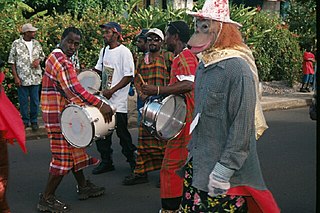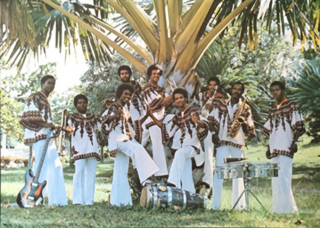Soca music is a genre of music defined by Lord Shorty, its inventor, as the "Soul of Calypso", which has influences of African and East Indian rhythms. It was originally spelled "sokah" by its inventor but through an error in a local newspaper when reporting on the new music it was erroneously spelled "soca"; Lord Shorty confirmed the error but chose to leave it that way to avoid confusion. It is a genre of music that originated in Trinidad and Tobago in the early 1970s and developed into a range of styles during the 1980s and after. Soca was initially developed by Lord Shorty in an effort to revive traditional calypso, the popularity of which had been flagging amongst younger generations in Trinidad due to the rise in popularity of reggae from Jamaica and soul and funk from the United States. Soca is an offshoot of calypso/kaiso, with influences from East Indian rhythms and hooks.
Calypso is a style of Caribbean music that originated in Trinidad and Tobago during the early to mid-19th century and spread to the rest of the Caribbean Antilles by the mid-20th century. Its rhythms can be traced back to West African Kaiso and the arrival of French planters and their slaves from the French Antilles in the 18th century.
The music of Martinique has a heritage which is intertwined with that of its sister island, Guadeloupe. Despite their small size, the islands have created a large popular music industry, which gained in international renown after the success of zouk music in the later 20th century. Zouk's popularity was particularly intense in France, where the genre became an important symbol of identity for Martinique and Guadeloupe. Zouk's origins are in the folk music of Martinique and Guadeloupe, especially Martinican chouval bwa, and Guadeloupan gwo ka. There's also notable influence of the pan-Caribbean calypso tradition and Haitian kompa.
The music of Guadeloupe encompasses a large popular music industry, which gained in international renown after the success of zouk music in the later 20th century. Zouk's popularity was particularly intense in France, where the genre became an important symbol of identity for Guadeloupe and Martinique. Zouk's origins are in the folk music of Guadeloupe and Martinique, especially Guadeloupan gwo ka and Martinican chouval bwa, and the pan-Caribbean calypso tradition.

The music of Dominica includes a variety of genres including all the popular genres of the world. Popular music is widespread, with a number of native Dominican performers gaining national fame in imported genres such as calypso, reggae, soca, kompa, zouk and rock and roll. Dominica's own popular music industry has created a form called bouyon, which combines elements from several styles and has achieved a wide fanbase in Dominica. Groups include WCK, Native musicians in various forms, such as reggae, kadans (Ophelia Marie, and calypso, have also become stars at home and abroad.
The music of the Lesser Antilles encompasses the music of this chain of small islands making up the eastern and southern portion of the West Indies. Lesser Antillean music is part of the broader category of Caribbean music; much of the folk and popular music is also a part of the Afro-American musical complex, being a mixture of African, European and indigenous American elements. The Lesser Antilles' musical cultures are largely based on the music of African slaves brought by European traders and colonizers. The African musical elements are a hybrid of instruments and styles from numerous West African tribes, while the European slaveholders added their own musics into the mix, as did immigrants from India. In many ways, the Lesser Antilles can be musically divided based on which nation colonized them.
Webert Sicot was a Haitian saxophone player, composer and band leader. He is recognized as one of the creators of compas also known as compas direct, a style of Haitian music born in the 1950s that he named cadence rampa after he left Nemours' band to differentiate himself in 1962 in the spirit of competition.
Kassav' is a French Caribbean band formed in Guadeloupe in 1979. The core members of the band are Jacob Desvarieux, Jocelyne Béroard, Jean-Philippe Marthély, Patrick Saint-Éloi, Jean-Claude Naimro, Claude Vamur, and Georges Décimus. Kassav' have issued over 20 albums, with a further 12 solo albums by band members.
Compas, also known as compas direct in French, konpa dirèk in Haitian Creole, or simply konpa but most commonly as Kompa is a modern méringue dance music genre of Haiti. The genre was popularized by Nemours Jean-Baptiste following the creation of Ensemble Aux Callebasses in 1955, which became Ensemble Nemours Jean-Baptiste in 1957. The frequent tours of the many Haitian bands have cemented the style in all the Caribbean. Therefore, compas is the main music of several countries such as Dominica and the French Antilles. Whether it is called zouk, where French Antilles artists of Martinique and Guadeloupe have taken it, or konpa in places where Haitian artists have toured, this méringue style is influential in part of the Caribbean, Portugal, Cape Verde, France, part of Canada, South and North America.

The culture of Dominica is formed by the inhabitants of the Commonwealth of Dominica. Dominica is home to a wide range of people. Although it was historically occupied by several native tribes, it was the Taíno and Island Caribs (Kalinago) tribes that remained by the time European settlers reached the island. "Massacre" is a name of a river dedicated to the murders of the native villagers by both French and British settlers, because the river "ran red with blood for days." Each claimed the island and imported slaves from Africa. The remaining Caribs now live on a 3,700-acre (15 km2) Carib Territory on the east coast of the island. They elect their own chief.
Cadence rampa, or simply kadans, is a dance music and modern méringue popularized in the Caribbean by the virtuoso Haitian sax player Webert Sicot in the early 1960s. Cadence rampa was one of the sources of cadence-lypso. Cadence and compas are two names for the same Haitian modern méringue.
Cadence-lypso is a fusion of cadence rampa from Haiti and calypso from Trinidad and Tobago that has also spread to other English speaking countries of the Caribbean. Originated in the 1970s by the Dominican band Exile One, it spread and became popular in the dance clubs around the Creole world and Africa as well as the French Antilles.
Exile One is a cadence musical group founded by Gordon Henderson in the 1970s with musicians invited over from Dominica, to be based in Guadeloupe. The band was influential in the development of Caribbean music. It became famous throughout the Caribbean, Europe, Africa and the Indian Ocean. Exile One opened the way for numerous Cadence-Lypso artists as well as for Zouk.

Les Aiglons was a 1970s Guadeloupean cadence band. Their single "Cuisse-la" was the greatest selling record of any Antillean band until Kassav's Zouk la sé sèl médikaman nou ni in 1985.
The WCK Band (Windward Caribbean Kulture) was formed in 1988 in Dominica. The band played a blend of the local Cadence-lypso and traditional Jing ping, Chante mas and lapo kabwit rhythms, which would later be labelled bouyon, a genre which they are credited with creating in the late 1980s.
Bouyon is a genre of Dominican music that originated in Dominica in the late 1980s. Prominent bouyon groups include Windward Caribbean Kulture (WCK); Roots, Stems and Branches (RSB); and First Serenade.
The World Creole Music Festival (WCMF) is an annual three-day music festival hosted on the island of Dominica during the final weekend in October, as a conclusion to Creole heritage month.

As an overseas department of France, Martinique's culture is French and Caribbean. Its former capital, Saint-Pierre, was often referred to as the Paris of the Lesser Antilles. The official language is French, although many Martinicans speak a Creole patois. Based in French, Martinique's Creole also incorporates elements of English, Spanish, Portuguese, and African languages. Originally passed down through oral storytelling traditions, it continues to be used more often in speech than in writing.

Caribbean music in Canada has existed since the early 1920s, becoming increasingly prominent after the 1960s as Caribbean immigration to Canada increased. Anglo-Caribbean genres such as reggae, soca and calypso are especially prominent in English Canada, while French Caribbean genres such as cadence-lypso, zouk and konpa are more prominent in Quebec.
Bouyon soca is a fusion-genre of bouyon music originating from Dominica and soca music originating from Trinidad & Tobago and the other English speaking Caribbean islands. Bouyon soca typically blends old bouyon music rhythms from the 90s' and soca music creating a unique style soca sound. The style of music was made more popular to the Caribbean region by the likes of the producer Dada and artists ASA from Dominica with collaborations from Trinidadian and St.Vincent artist such as Skinny Fabulous, Bunji Garlin, Iwer George and Machel Montano. Noticeable hits includes Famalay and Conch Shell. With noticeable Bouyon flavored rhythms and sounds with the essence of Soca tempo and lyrical attributes.




